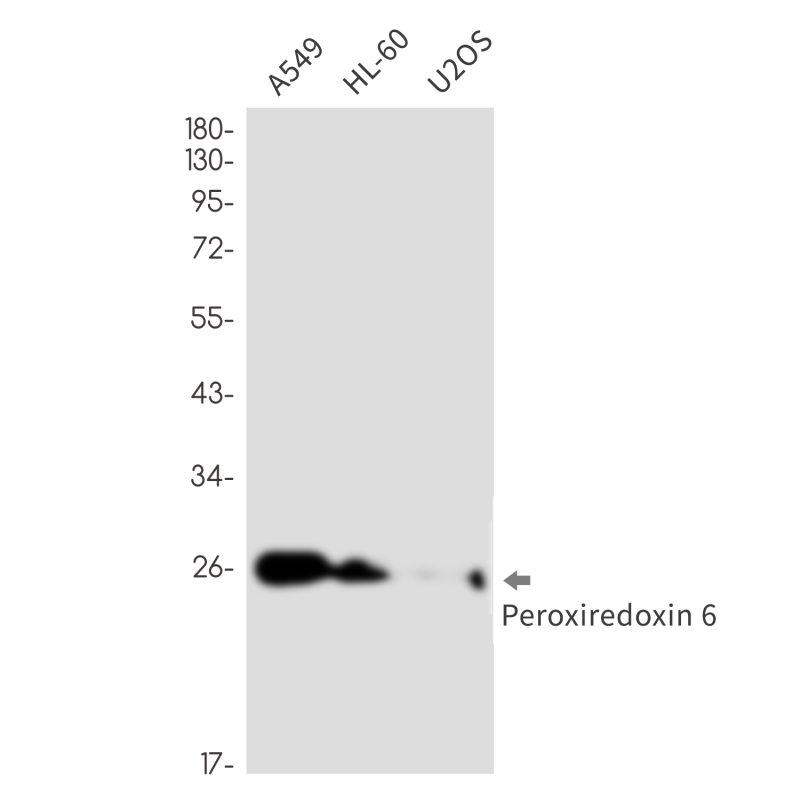
| WB | 1/500-1/1000 | Human,Mouse,Rat |
| IF | 1/20 | Human,Mouse,Rat |
| IHC | 咨询技术 | Human,Mouse,Rat |
| ICC | 技术咨询 | Human,Mouse,Rat |
| FCM | 咨询技术 | Human,Mouse,Rat |
| Elisa | 咨询技术 | Human,Mouse,Rat |
| Aliases | Peroxiredoxin-6; Antioxidant protein 2; Liver 2D page spot 40; NSGPx; PRDX6; AOP2; KIAA |
| Entrez GeneID | 9588 |
| WB Predicted band size | Calculated MW: 25 kDa; Observed MW: 25 kDa |
| Host/Isotype | Rabbit IgG |
| Antibody Type | Primary antibody |
| Storage | Store at 4°C short term. Aliquot and store at -20°C long term. Avoid freeze/thaw cycles. |
| Species Reactivity | Human |
| Immunogen | A synthetic peptide of human Peroxiredoxin 6 |
| Formulation | Purified antibody in TBS with 0.05% sodium azide,0.05%BSA and 50% glycerol. |
+ +
以下是3篇与Peroxiredoxin 6(PRDX6)抗体相关的文献摘要示例:
---
1. **文献名称**:*"Peroxiredoxin 6: a bifunctional enzyme with glutathione peroxidase and phospholipase A₂ activities"*
**作者**:Fisher, A.B. et al.
**摘要**:本研究利用特异性PRDX6抗体,通过免疫组织化学和Western blot技术,揭示了PRDX6在小鼠肺组织中的高表达及其双重酶功能。抗体验证实验表明其在氧化应激模型中能特异性识别PRDX6.并证实其参与细胞膜磷脂修复过程。
---
2. **文献名称**:*"PRDX6 modulates NADPH oxidase activity and oxidative stress-induced apoptosis in neurons"*
**作者**:Manevich, Y. et al.
**摘要**:通过免疫共沉淀和免疫荧光技术,研究团队使用高特异性PRDX6抗体,发现PRDX6与NADPH氧化酶复合物的相互作用。抗体阻断实验证明PRDX6通过调控活性氧(ROS)水平影响神经元凋亡,为神经退行性疾病机制提供了新见解。
---
3. **文献名称**:*"Altered expression of peroxiredoxin 6 in aggressive breast cancer and its diagnostic implications"*
**作者**:Shukla, S.K. et al.
**摘要**:该研究通过免疫组化分析(使用PRDX6多克隆抗体)发现,乳腺癌组织中PRDX6表达显著上调,且与患者预后不良相关。抗体特异性通过siRNA敲低实验验证,提示PRDX6可能作为乳腺癌生物标志物。
---
注:上述文献信息为示例性概括,实际引用需以具体发表的论文内容为准。建议通过PubMed或Web of Science以“Peroxiredoxin 6 antibody”为关键词检索最新研究。
Peroxiredoxin 6 (PRDX6) is a multifunctional antioxidant enzyme belonging to the peroxiredoxin family, which plays a critical role in regulating cellular redox homeostasis. Unlike other peroxiredoxins, PRDX6 contains a single conserved cysteine residue and exhibits unique enzymatic activities, including glutathione peroxidase and phospholipase A2 functions. It neutralizes reactive oxygen species (ROS), protects cells from oxidative damage, and participates in lipid metabolism, cell signaling, and inflammatory responses. PRDX6 is widely expressed in tissues, particularly in the lungs, liver, and brain, and its dysregulation has been linked to pathologies such as cancer, neurodegenerative diseases, and acute lung injury.
Antibodies targeting PRDX6 are essential tools for studying its expression, localization, and function. They enable detection via techniques like Western blotting, immunohistochemistry, and immunofluorescence, aiding in the exploration of PRDX6’s role in oxidative stress-related mechanisms. Researchers also use these antibodies to investigate PRDX6’s interaction with other proteins and its post-translational modifications, which modulate its activity. Additionally, PRDX6 antibodies have potential diagnostic applications, as altered PRDX6 levels in biofluids or tissues may serve as biomarkers for diseases like lung cancer or Alzheimer’s. The development of highly specific monoclonal and polyclonal antibodies has enhanced the precision of PRDX6 research, supporting advances in understanding its dual role as a cytoprotectant and a regulator of pathological processes.
×